这个演示将是关于创建一个温暖的发光的场景在海滩上。使用您已经掌握的关于颜色和价值,我们将创建一个复杂的场景和简化的形状和颜色/值的关系。
颜色之间的关系是非常重要的,你必须计上所有主要的颜色在一个场景。在这种情况下,主要的颜色是棕色的,一切都将关系到它。现场的光线影响每个对象的颜色。绿色你将混合可能看起来tan相比纯蓝色,紫色和蓝色可能出现灰色。当这些颜色放在一起,它们所形成的关系,我们下意识的理解。
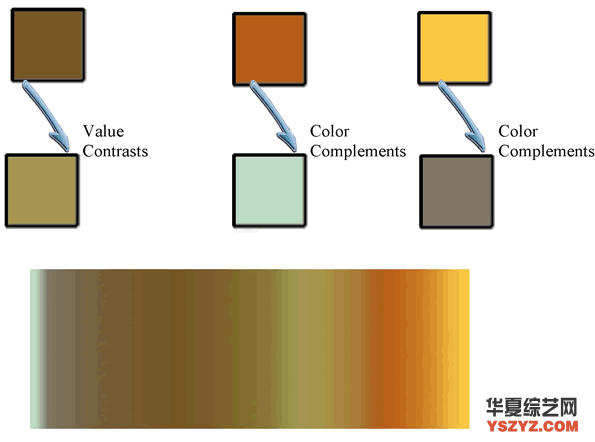
以上是一个泛化的配色方案将工作与照明的场景。左边的颜色很酷的阴影和反射突出。右边是最温暖的颜色,最明亮的地区。反映突出是一个伟大的方式来添加兴趣和变异的照明在绘画。
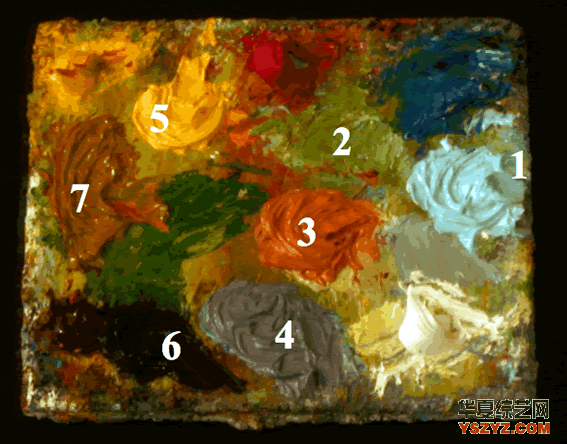
调色板基金会是镉黄灯、镉红,蓝,深褐色,锰和钛白色。颜色混合是(1)白色+蓝色(2)白+黄+蓝+红(3)红+黄
(4)蓝+红色+白色(5)黄+白+红(6)深褐色+蓝色(7)黄色+深褐色。
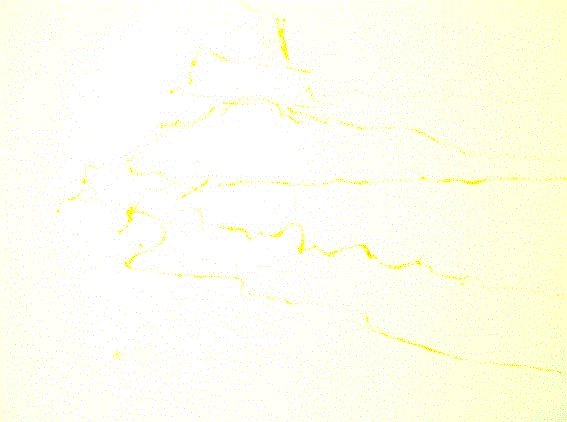
我在主要轮廓草图计划使用浅色的绘画。这一步是重要的保持非常基本的比例正确的从一开始,而不是结束。
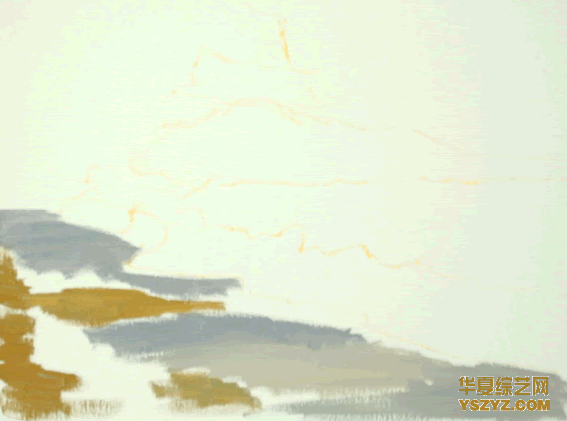
涂料前景砂(4)附近地区的水和背面,(7)靠近左边。组合(3)+(4)和白色来得到一个漂亮的灰色,包括颜色。覆盖了大部分的地区与灰色的颜色。
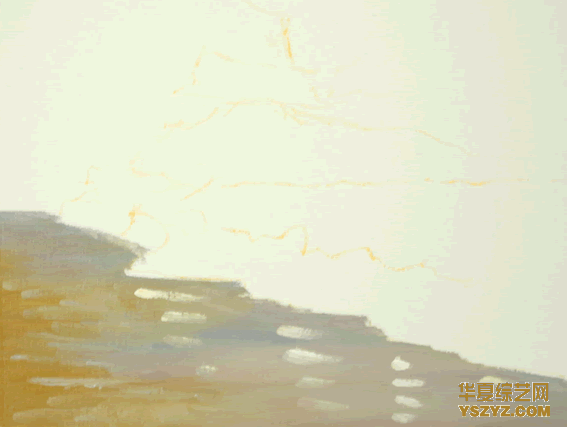
混合在一起的沙子颜色有点中边缘满足。然后添加条纹的白色面前的任何地方泡沫可能伸出一些。这些将被反射在潮湿的沙子。

用一个软刷子,一个尼龙榛子效果很好,混合沙的颜色在一起。使用非常小的压力和扫描前后水平。这将模拟模糊反射的颜色。
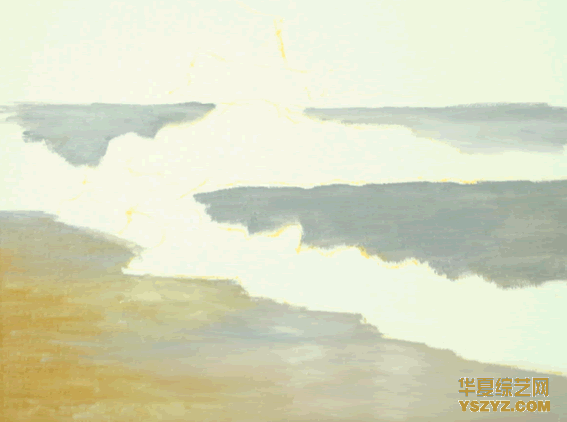
填海地区的紫色灰色(4),中台海可以略轻于价值。
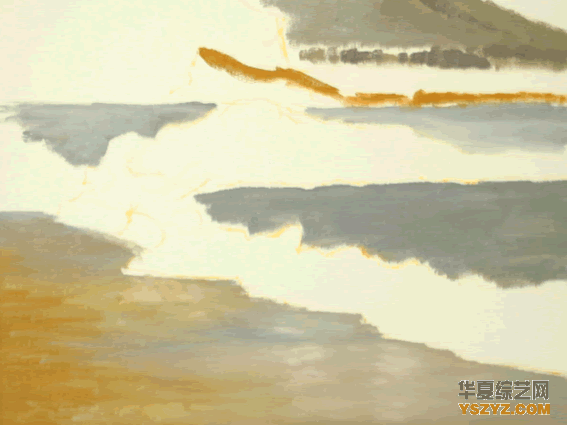
使用紫色灰色(4)和混合绿色(2)来得到一个漂亮的灰色的背景半岛。保持对角的边缘画。在这个基地,使用短垂直中风。一些中风应该的purpl(4),和其他人应该橙(7)见下一步。也添加了橙色的线的岩石。
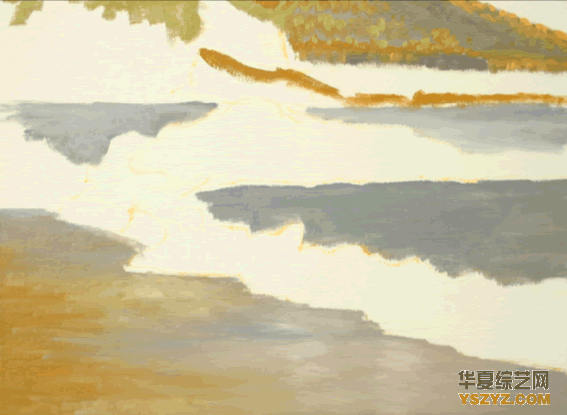
接下来,将少量的橙色的上部边缘的遥远的penisula,沿着基地。使用灰色绿色(2)在一些半岛和顶的中台岬。
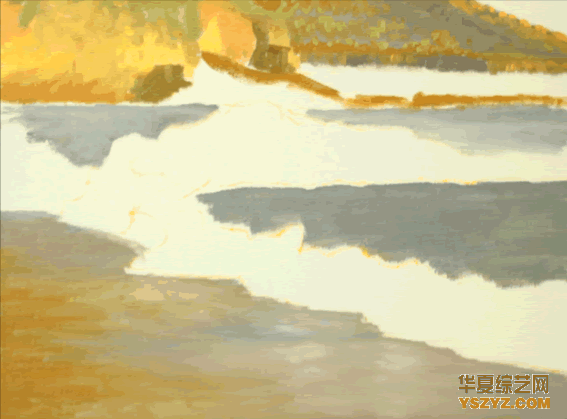
填写中台岬褐色皮肤的颜色(5),加入其他的棕色和灰色中风,
(7)在该基地,和(3)中心附近。岩石铸一个浅灰色的影子在海岬上。阴影的颜色混合与(7 + 6)。它应该是轻于最黑暗的区域的岩石。添加相同的阴影颜色的边缘岬创建自己的影子。
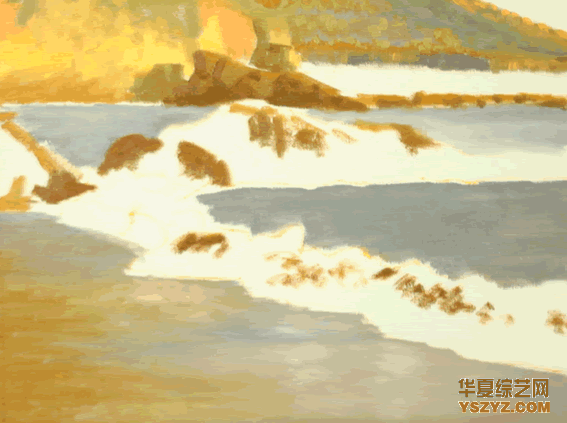
用一个棕色的颜色(7 +深褐色)填写背景岩石和岩石地区的前景。还把棕色小中风在中间的前景波。不要创建一个固体。
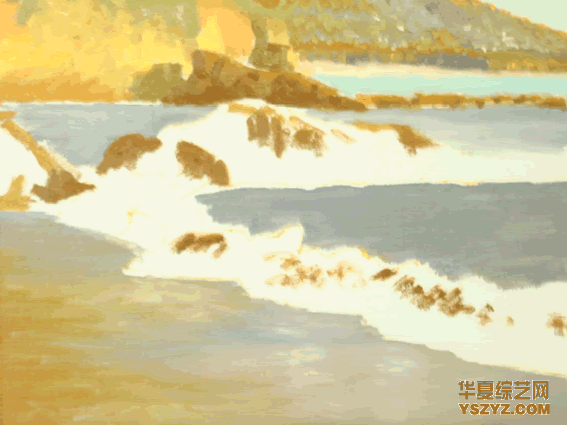
添加遥远的海与浅蓝色(1)。然后添加白色到相同的颜色来画在天空。海滩的颜色应该是一个浅棕色(7 + 5 +白)。一些白色的中风在遥远的山增加深度和兴趣。

完成前台岩石与深棕色。最接近的摇滚应该最黑暗的阴影。接下来的最远的应该有更多的深褐色的混合物来减轻颜色。把短,波涛汹涌的中风具有相同颜色的底部波后退时。
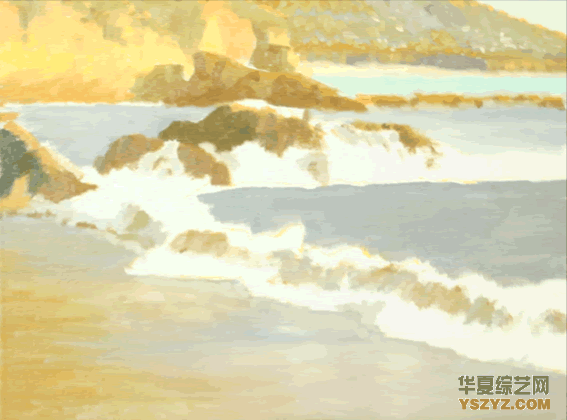
阴凉处的泡沫应该是浅灰色,所以使用一个混合的紫色(4)和白色。增加了泡沫在地区的岩石,也混在一起棕色的波浪。现在这个中间区域的波可以变得更加集中。
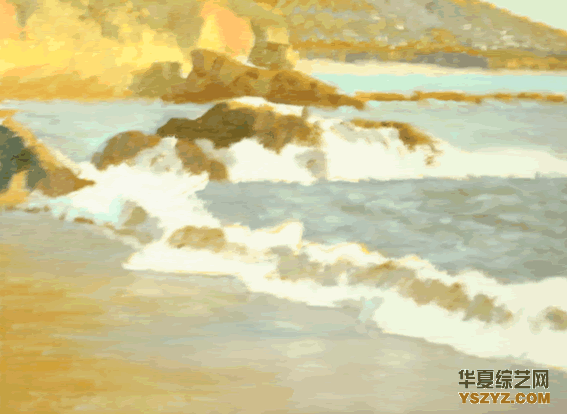
接下来,添加一个浅蓝色(1)在泡沫的基地在靠近前面的岩石。使用相同的颜色和小、浅、“U”型中风的海洋创建小波。
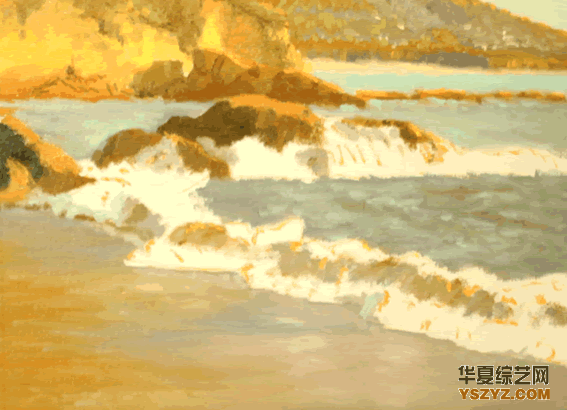
添加光色(3)来完成他们的岩石。也添加一些橙颜色棕色的部分的波。
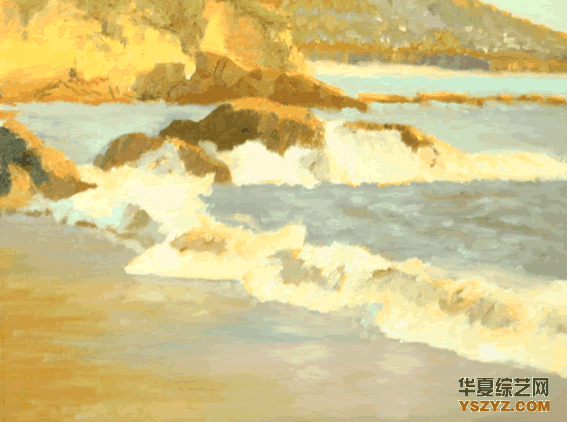
使用一个装配工刷添加温暖,浅色(7 +白)边缘的泡沫,在白色区域的边缘。这将保持白色的中心更多的纯和温暖的边缘。
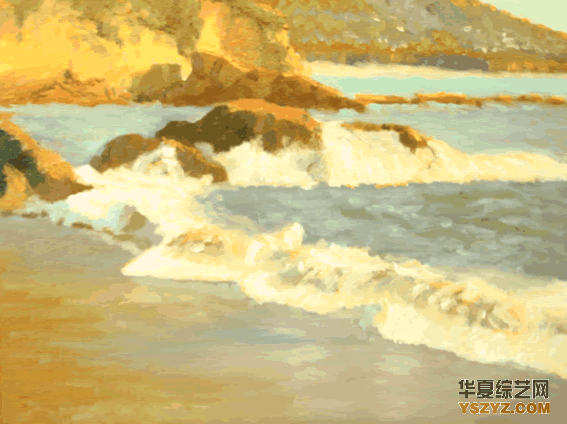
现在,使用一个小的圆形笔刷来平滑干净的白色油漆所有泡沫区域。
最后是开门见山。添加紫色
(4)或浅蓝色(1)到阴凉处的泡沫。润色岩石颜色有不同深浅的橙色。与纯粹的深褐色,轻拍于左下角创建一个感觉破碎的倒影。最后,油漆在另一层很薄的水在前面的泡沫,用浅蓝色(1),混合它回到波和泡沫。
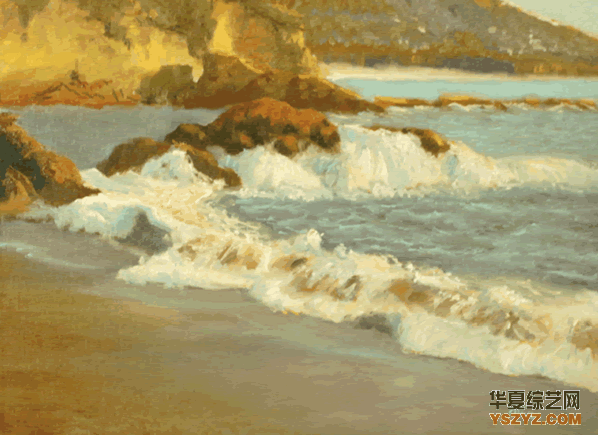
原文如下:
Seascape Painting Demonstration By Brian Oliver
This demonstration will be about creating a warm glowing scene at the beach. Using what you have already learned about color and value, we’ll create a complex scene with simplified shapes and color/value relationships.
The relationships of color are very important, you must gauge everything off the major color in a scene. In this case, the major color is brown, and everything will be in relation to it. The light of the scene influences the color of every object. Greens you will mix might look tan when compared to pure blue, purples and blues may appear gray. When these colors are put together, they form the relationships that we subconsciously understand.
Above is a generalization of how this color scheme will work with the lighting of the scene. To the left are the colors of cool shadows and reflected highlights. To the right are the colors of the warmest, most brightly lit areas. Reflected highlights are a great way to add interest and variation to the lighting in a painting.
The palette foundation is cadmium yellow light, cadmium red, maganese blue, burnt sienna, and titanium white. The colors mixes are (1) white+blue (2) white+yellow+blue+red (3)red+yellow
(4) blue+red+white (5) yellow+white+red (6) burnt sienna+blue (7) yellow+burnt sienna.
I sketch in the main outlines to plan the painting using a light color. This step is important to keep very basic proportions correct from the beginning rather than at the end.
Paint the foreground sand with (4) in the areas near the water and to the back, and (7) near the left. Mix (3) + (4) and white to get a nice gray and include that color as well. Cover most of the area with the gray color.
Blend the sand colors together somewhat where the edges meet. Then add streaks of white in front of any place where the foam might stick out some. These will be reflections on the wet sand.
Use a soft brush, a nylon filbert works well, to blend the sandy colors together. Use very little pressure and sweep back and forth horizontally. This will imitate blurred reflected colors.
Fill in the sea areas with a purple gray (4). The middleground sea can be slightly lighter in value.
Use the purple gray (4) and mix with green (2) to get a nice gray for the background peninsula. Keep the diagonal near the edge of the painting. At the base, use short vertical strokes. Some strokes should be of the purpl (4), and others should be of orange (7) as seen in the next step. Also add the orange to the line of rocks.
Next, place small amounts of the orange at the upper edge of the distant penisula, and along the base. Use a gray green (2) in some of the peninsular and on the top of the middleground headland.
Fill in the middleground headland with a tan color (5). Add stroke of other browns and grays,
(7) at the base, and (3) near the center. The rock casts a light gray shadow on the headland. Mix the shadow color with (7+6). It should be lighter than the darkest area of the rock. Add the same shadow color to the edge of the headland where it creates its own shadow.
Use a brown color (7 + burnt sienna) to fill in the background rocks and the foreground rock areas. Also put the brown color in small strokes in the middle of the foreground wave. Don’t create one solid mass.
Add the distant sea with a light blue (1). Then add white to the same color to paint in the sky. The beach color should be a light tan (7+5+white). Some white strokes in the distant hills adds depth and interest.
Finish the foreground rocks with darker browns. The closest rock should have the darkest shadow. The next furthest should have more burnt sienna in the mixture to lighten the color. Put short, choppy strokes with the same color at the base of the wave as it recedes.
The shady areas of foam should be light gray, so use a mix of purple (4) and white. Add to the foam on areas of the rocks and also mix in with the brown color in the wave. Now this middle area of the wave can become more massed.
Next, add a light blue (1) at the foam’s base near the front rock. Use the same color and small, shallow, “U” shaped strokes to the ocean to create wavelets.
Add the light color (3) to the rocks to complete them. Also add some of the orange color to the brown parts of the wave.
Use a rigger brush to add warm, light color (7 + white) to the edges of the foam, all around the white area edges. This will keep the white in the center more pure and warmer at the edges.
Now, use a small round brush to smooth clean white paint over all the foam areas.
The final touches are straight forward. Add purple
(4) or light blue (1) to the shady areas of foam. Touch up the rock color with varying shades of orange. With pure burnt sienna, dab at the lower left corner to create a felling of broken reflections. Lastly, paint in another layer of very thin water in front of the foam with light blue (1), blend it back towards the wave and foam.








